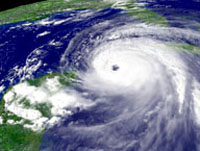Climate change causes collapse of civilisations
New research suggests that climate change led to the collapse of the most splendid imperial dynasty in China’s history and to the extinction of the Maya civilisation in Central America more than 1,000 years ago.

There has never been a satisfactory explanation for the decline and fall of the Tang emperors, whose era is viewed as a highpoint of Chinese civilisation, while the disappearance of the Maya world perplexes scholars.
Now a team of scientists has found evidence that a shift in monsoons led to drought and famine in the final century of Tang power. The weather pattern may also have spelt doom for the Maya in faraway Mexico at about the same time, they say.
Both ruling hierarchies at the start of the 10th century were victims of poor rainfall and starvation among their peoples when harvests failed.
The martial arts honed during the fall of the Tang still provide a staple of modern Chinese epic films and video games, while Mel Gibson, the actor-director, has just released Apocalypto, a blood-drenched film set in the last days of the Maya.
The Maya practised human sacrifices to please the gods of rain and Chinese soothsayers were employed by the court to divine the seasons, yet neither could have predicted the slow-motion catastrophe resulting from the changing weather.
The cause was to be found in the migration of a band of heavy tropical rain, which moves in response to phenomena such as El Niño (a weather effect created by huge surface temperature fluctuations in tropical eastern Pacific waters), the scientists argued in an article in Nature last week.
The effect was to end two golden ages which existed in ignorance of one another on opposite sides of the world.
The scientific team, led by Gerald Haug of Germany’s national geosciences research centre, found that a massive movement in tropical rainfall took place in early 900 both in China and in Central America, the Sunday Times reports.
They have found a startling correlation between climate extremes and the fall of two great civilisations: the Tang dynasty in China and the Maya of South America. “It blew me away," says Haug.
The records show that around the time that these civilizations went into decline, they experienced stronger than average winds in the winter and weaker summer monsoon rains. These weak rains would have reduced crop yields.
Records of monsoons beyond the last 50 years are difficult to obtain. Looking for signs of monsoon trends in geological records going back thousands of years can help solve this problem. In China, stalagmites provide the best available historical record of summer monsoon rains, says Haug, as more rain increases the amount of water dripping down from the roofs of caves. But until now, there has been no reliable estimate of winter winds.
Haug and his colleagues solved this problem by studying the sediments deposited at the bottom of Lake Hugauang Maar in southeastern China. The sediments are made up primarily of material deposited there by winter monsoon winds because the catchment area is small, meaning very few streams bring in sediments from other sources. As a result, the sediments provide an accurate historical record of the strength of the winter monsoon winds.
The researchers looked at iron and titanium levels in a sediment core that was extracted from the lake floor. The oxidation level of the iron told them how much oxygen was present in the lake waters when the sediments were deposited, and therefore how much wind was stirring up the lake surface. Titanium in particles is non-reactive and the quantities accumulated in the layers of sediment provided another measure of wind strength, the New Scientist reports,
When they compared the 16,000 years represented by the mud core, the researchers found that years of strong winter winds corresponded very closely to strong summer rains and vice versa. "Our sediment data provides a mirror image to summer records in stalagmites," explains Haug.
The researchers believe the only coherent explanation for the summer and winter trends and is a shift in the position of a band of low-pressure that girdles the Earth, known as the inter-tropical convergence zone, or ITCZ.
They found that when warm temperatures in the Northern hemisphere indicated a northward shift of the ITCZ, summer monsoon rains were strong and winter monsoon winds were weak. "It seems possible that major shifts in ITCZ catalysed simultaneous events in civilisations on opposite sides of the Pacific Ocean," conclude the researchers in a paper in Nature.
Source: agencies
Prepared by Alexander Timoshik
Pravda.ru
Subscribe to Pravda.Ru Telegram channel, Facebook, RSS!


